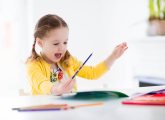Surround children with the things they encounter at home, plus a generous helping of curios, and watch them learn, says Kirstine Beeley…
Reading material
Central to the Characteristics of Effective Learning is the idea that “children learn best with what they know” and there is much we can do to bring the real world that children are familiar with into our settings.
What to try
Early reading is far from being just about phonics and storybooks; it’s also about building children’s confidence to attack new words and new situations. Promoting reading for a reason around your setting will help to develop this confidence. Try adding real packets and tins into your role play, plus real magazines, newspapers and TV guides, calendars, comics and lots of logos. Children who can recognise their local supermarket, favourite TV programme or fast food chain logos can then be encouraged to look at less familiar texts with renewed gusto and buoyed by success.
Remember…
The above are all examples of what most of us use reading for on a daily basis – the type of reading children will see going on around them outside your setting.
Intriguing objects
Introducing assorted ‘bits and bobs’ around your setting is a great way to bring out children’s natural curiosity about the world around them…
What to try
Many of us will recall experiencing a particular enthusiasm to explore and play at our grandparents’ houses when we were younger. Recreating that sense of old-fashioned ‘magic’ by filling your setting with intriguing trinkets (think everything from ornaments to thimbles, and coins to costume jewellery) can bring out imaginative play, talk and cooperative skills. Children afforded china and porcelain cats, dogs and pigs, for example, are able to imagine and play out scenarios that are so much more exciting to them than with plastic farmyard toys, and exploring colours, textures and materials that are unfamiliar builds not only early exploration and questioning skills but also stimulates young brains’ sensory synapses.
Remember…
Providing children with real objects helps them to build real learning in an engaging, home-from-home environment.
Plastic-free
There is an increasing movement within early years in many countries to break away from the use of plastic and embrace real-world resources…
What to try
Include real pots and pans in role play and mud kitchens to encourage children to revisit situations they’ve experienced and to play imaginatively. The use of authentic crockery, cups and saucers is not just an aesthetic choice; in giving children access to resources that are not indestructible we encourage a sense of care and pride in their surroundings and develop their understanding of cause and effect: “If we throw this saucer it will break and we will no longer have it to play with.” With careful risk assessment the use of these items quickly develops a shared sense of belonging and builds life skills that children can transfer to their home settings.
Remember…
Parents would much prefer us to teach our children to be careful with their precious objects than to give them a false sense of the world being unbreakable.
Children need to understand both the ‘mechanics’ of maths and its application…
In early years there are lots of ways to bring real and significant numerals into our settings. Thinking about all the ways we, as adults, come into contact with number helps us to replicate similar experiences in our settings. Try adding clocks (digital and analogue), remote controls, food packets and tins. Birthday cards can be used to create a real-world number line with real significance to the children, and old mobile and landline phones can be used with self-made imaginary phone books – imagine the excitement of being able to dial up Spider-Man or Peppa Pig!
Kirstine Beeley is an author and educational consultant. Visit playingtolearnuk.com.

Easy ways to support mark making in the early years
Editors picks
